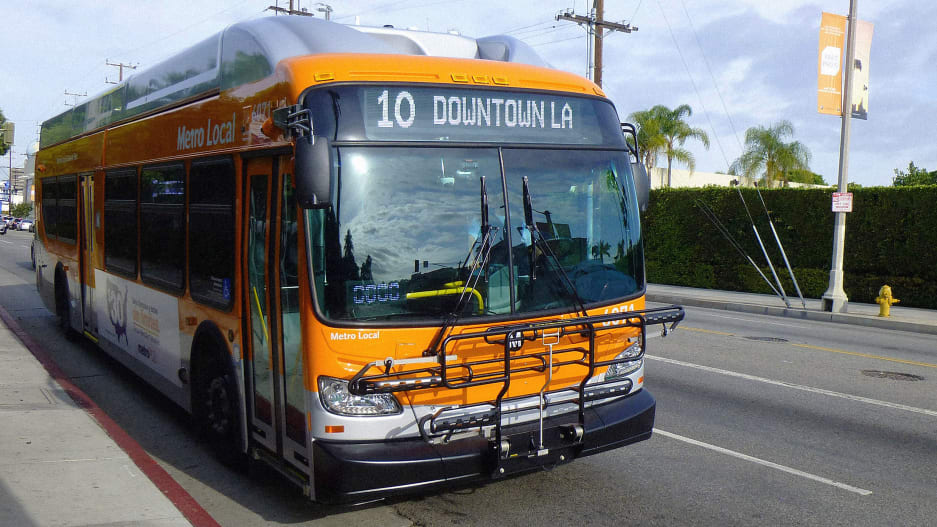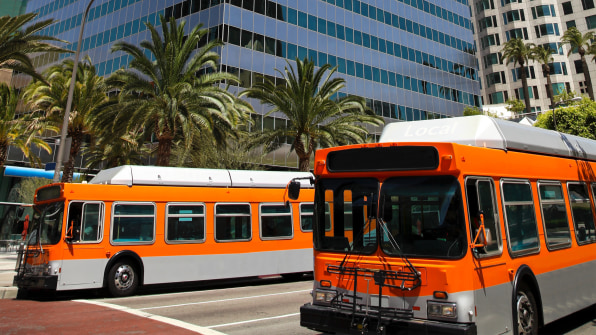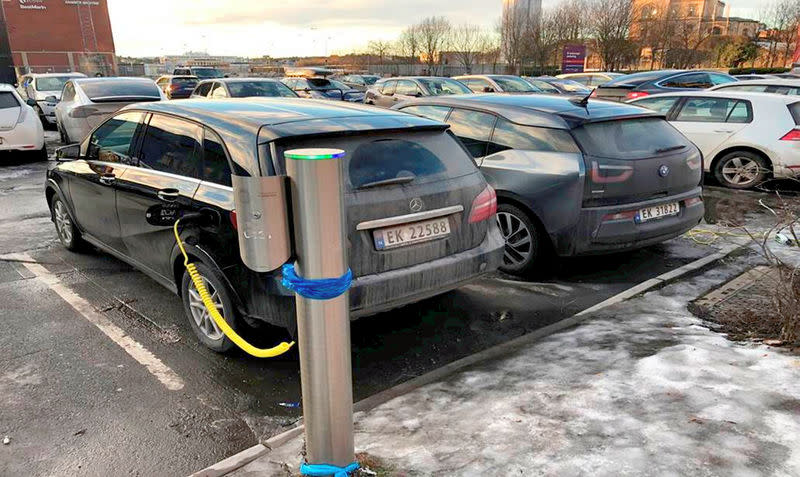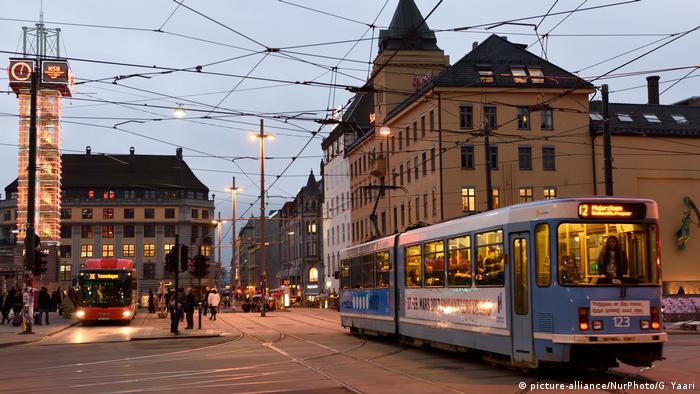What’s affecting production, and why automakers send their limited supply to certain provinces first

Ford’s North American president, Kumar Galhotra, stands in front of the new all-electric Mustang Mach-E SUV as it is revealed to employees in Dearborn, Mich. (Jill English/CBC)
It says something about a vehicle when it isn’t yet in production, but it’s already sold out.
Within 10 days of launching the first-ever Ford Mustang SUV, the Mach-E, the coveted First Edition model had already met its order maximum. It’s also the first Mustang in the muscle car’s 55-year history to be all-electric.
“Zero-to-60 is going to be under four seconds,” Ford’s North American president, Kumar Galhotra, was quick to brag during an interview at the manufacturer’s Michigan headquarters.
“There’s a huge market segment of Mustang enthusiasts who want a vehicle like this, because it’s more versatile. It gives them room for family, for friends, for cargo.”
The high-speed sell-out is only partly explained by the Mustang brand’s popularity, and the roomier new design. The Mach-E is facing the same supply crunch being experienced by most other automakers entering the battery-only electric vehicle (BEV) fray.
Supply and demand
Canadian roads are filled with 25 million vehicles, and right now only about 136,000 of them are electric. But EVs could be on the verge of a breakthrough.
In a report by Clean Energy Canada, 54 per cent of Canadians polled in March said they’re inclined to buy electric for their next vehicle. One in 10 are certain they will.

Getting one is a challenge, though.
With the notable exception of the Tesla Model 3, the world’s best selling BEV, orders for electric vehicles can take months to fill — and sometimes as long as a year, depending where you live.
Interested in a Hyundai Kona EV in Halifax, for example? You could be looking at a six-month delay.
“It’s tough as a consumer to walk in and say ‘hey do you have one of these? Can I test drive it?,’ says salesman John Yeadon of Steele Hyundai in Halifax. “That’s not really easy right now.”
Often, he says, the only way he can show potential buyers what the car looks like is to hand them a brochure.
Some dealers can’t even do that. They just don’t sell EVs.
And don’t want to.
“It’s a business risk,” explains Mike Currie of Atlantic Canada’s Steele Auto Group. “I think a lot of other dealers are just waiting until it all comes, but we want to be ahead of it. We want to be the leaders in offering electric vehicles.”
Currie’s group sells EVs at all 40 dealerships it owns across Atlantic Canada. But that costs money: to install chargers, and to train sales staff and mechanics.
And, with fewer moving parts, EVs don’t break as often as gasoline-powered vehicles, so they generally don’t require as much service. That presents a challenge to dealerships that tend to make more money in their garage than on their sales floor.
“We just have to find new ways of making money,” Currie says.
Boosting availability
While the number of EVs on the road in Canada is increasing, they are not evenly distributed.
Only 0.2 per cent of Canada’s electric vehicles are in Nova Scotia. Quebec, meanwhile, has 43 per cent of the national total. That disparity is not just about differences in population.
Some provinces have used laws and incentives to boost availability.
For one, Quebec offers up to an $8,000 rebate on the purchase of a new EV. That’s in addition to the $5,000 federal rebate. Together, these incentives have helped drive sales.

Simon Fraser University’s Jonn Axsen studies transitions to sustainable energy systems. He says government policy is critical to getting EVs onto Canadian roads. (Glen Kugelstadt/CBC)
But Jonn Axsen of Simon Fraser University gives most of the credit to Quebec’s ZEV mandate, a law requiring automakers to sell a minimum number of zero-emission electric vehicles if they want to sell gas-powered vehicles in the province.
When automakers are looking at where to put their limited supply of EVs, they start with areas where selling a minimum number is the law. British Columbia just introduced its own ZEV mandate, as have about a dozen U.S. states, including California.
“It is a policy meant to stimulate innovation,” says Axsen. “It’s a hard-sell for companies to make a huge investment into a brand new technology that’s very different than what they know, without having some certainty.”
The ZEV mandate, says Axsen, is that certainty. It’s a signal to automakers and their suppliers that EVs have a clear and imminent future, and that they’d better get moving on building up their EV supply chains to meet demand for things like batteries.
Battery availability
Sourcing EV components is something the industry is still grappling with. Automakers spend years, even decades, establishing elaborate supply chains. And some have only recently begun to add lithium ion batteries, the core of an electric vehicle, to those complex chains.
“It’s an industry that’s quite comfortable with the gasoline-powered vehicles that it has been selling,” says Axsen.
The long-standing myths about electric vehicles one reason they aren’t everywhere and subject to months-long waits. David Common looks at why and some incentives that could boost supply of electric vehicles. 9:24
Even so, manufacturers are boosting production. Ford plans to have 40 EV models worldwide by 2022.
The increased interest in EVs is creating unprecedented demand and competition between automakers to get access to things like batteries in a timely fashion.
General Motors, for instance, is partnering with LG Chem to build a $3 billion battery plant in Ohio.
Even so, like the dealerships, the car companies themselves are in the early stages of figuring out how to make money from EVs. And that means that when they launch a new EV model, it’s still often a limited production run to ensure their evolving supply chains can feed the factories — and until they are certain of demand.
Ford, for example, won’t say how many Mustang Mach-Es it will build when production gets under way. Though the company has said there will be more the following model year — a trend seen throughout the industry as EVs continue to creep into automakers’ offerings.
“The entire industry is going to go through this transition,” Ford’s Golhotra says.
“This is the first high-volume [EV] product we’re going to do. And our competitors are doing the same thing. So availability is going to grow.”
WATCH | The National’s feature on the hidden carbon footprint of electric vehicles:

How environmentally friendly are electric cars, really?
- 16 days ago
- 7:25
- Turn captions on
An electric car doesn’t produce emissions, but its parts still have a carbon footprint. We look at all the components of EVs, from how they’re charged to what’s in the battery to see how environmentally friendly they are. 7:25






 First, let the White Pines Wind Farm start creating clean green energy, since they are standing idle and doing no good for anyone.
First, let the White Pines Wind Farm start creating clean green energy, since they are standing idle and doing no good for anyone. Grocery stores need to do away with plastic bags, plastic packaging and plastic products such as straws, so consumers get in the habit of using reusable bags and containers.
Grocery stores need to do away with plastic bags, plastic packaging and plastic products such as straws, so consumers get in the habit of using reusable bags and containers.





